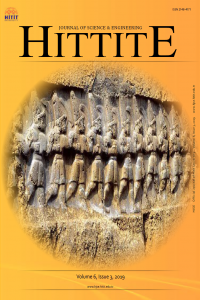Abstract
References
- Wills, Barry A., and James Finch. Wills' mineral processing technology: an introduction to the practical aspects of ore treatment and mineral recovery. Butterworth-Heinemann, pp. 258-342, 2005.
- Rao, DV Subba. Minerals and coal process calculations. CRC Press, 2016.
- Birinci, M., Miller, J. D., Sarıkaya, M., Wang, X. “The effect of an external magnetic field on cationic flotation of quartz from magnetite.” Minerals Engineering 23.10 (2010): 813-818.
- Manouchehri, H-R. “Magnetic conditioning of sulfide minerals to improve recovery of fines in flotation - a plant practice.” Minerals & Metallurgical Processing; Littleton 1 (2018): 46-54
Abstract
The aim of this study was to obtain a high grade and yield percentage of iron concentrate from a specularite ore by using wet magnetic separation and reverse flotation techniques. The processing a specularite sample using wet magnetic separation and reverse flotation method was studied. During the magnetic separation process, particle size was -2000 µm and magnetic field applied at 0.25 T and 0.85 T which were performed at a solid-liquid ratio of 10% and 20% by weight, respectively. In the reverse flotation tests, experimental design DOE was applied, statistically. Depressant dosage, collector dosage and flotation time were selected as main parameters. PH value, frother dosage MIBC and particle size were constant parameters. The results showed that particle size and magnetic field intensity had a significant effect on the iron concentrate grade and yield for wet magnetic separation. The optimum value of iron concentrate grade was 98.75% at 0.25 T and particle size of -150 µm while the highest value of iron concentrate yield was 67% at 0.75 T and particle size of -74 µm. In the flotation tests, depressant dosage had the greatest influence on the iron concentrate grade while the effect of the collector dosage and froth collection time were less. Froth collection time had the greatest effect on iron concentrate yield.The maximum iron concentrate grade was 90.13% for the following conditions: 5250 g/ton depressant, 1000 g/ton collector and 2-minute froth collection time. The maximum iron concentrate yield was 98.96% for the following conditions: 5250 g/ton depressant, 1500 g/ton collector and 1 min froth collection time under fixed conditions.
Keywords
Magnetic separation Reverse flotation Particle size Upgrading Specularite Experimental design.
References
- Wills, Barry A., and James Finch. Wills' mineral processing technology: an introduction to the practical aspects of ore treatment and mineral recovery. Butterworth-Heinemann, pp. 258-342, 2005.
- Rao, DV Subba. Minerals and coal process calculations. CRC Press, 2016.
- Birinci, M., Miller, J. D., Sarıkaya, M., Wang, X. “The effect of an external magnetic field on cationic flotation of quartz from magnetite.” Minerals Engineering 23.10 (2010): 813-818.
- Manouchehri, H-R. “Magnetic conditioning of sulfide minerals to improve recovery of fines in flotation - a plant practice.” Minerals & Metallurgical Processing; Littleton 1 (2018): 46-54
Details
| Primary Language | English |
|---|---|
| Journal Section | Research Article |
| Authors | |
| Publication Date | September 30, 2019 |
| Published in Issue | Year 2019 Volume: 6 Issue: 3 |
Cited By
Selective depression action of taurine in flotation separation of specularite and chlorite
International Journal of Mining Science and Technology
https://doi.org/10.1016/j.ijmst.2022.03.006
Hittite Journal of Science and Engineering is licensed under a Creative Commons Attribution-NonCommercial 4.0 International License (CC BY NC).


